
by successfulbob | bird photography, Lumix GX8, Lumix Lounge, photography, photography education, wildlife photography
Hummingbird Photo – Lumix GX8
Hanging out this morning and thought I’d do some camera testing with my Lumix GX8 and the 100-300mm G Vario f4-5.6 (200-600mm equivalent) lens. I made these images handheld with stabilization turned on. Settings for these were f14 1/2000th sec at ISO 6400. I’ll share some hummingbirds in motion images at different settings a little later. I became enamored of this little critter because he had so much peppy personality. Looks like he just arrived from a long migration. He’s not one of our local birds and seems a little worse for wear.
 Hummingbird Straight out of the camera. He’s checking me out.
Hummingbird Straight out of the camera. He’s checking me out.
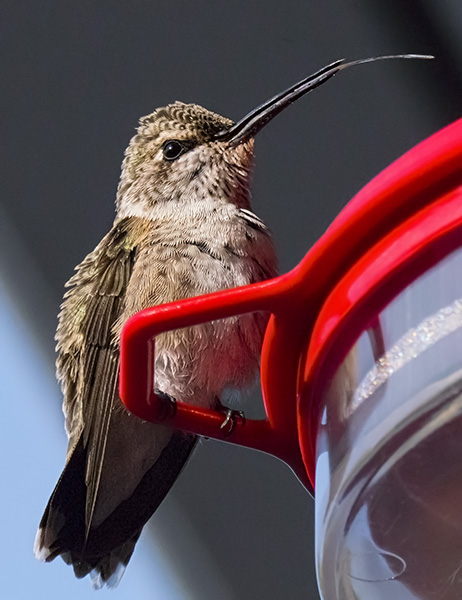 After seeing me, he stuck out his tongue! Not sure if that was social commentary or not. Here’s the little guy after processing with MacPhun Noiseless and MacPhun Tonality (for sharpening the feathers just a bit more. Explanation below)
After seeing me, he stuck out his tongue! Not sure if that was social commentary or not. Here’s the little guy after processing with MacPhun Noiseless and MacPhun Tonality (for sharpening the feathers just a bit more. Explanation below)
So these images turned into a processing exercise. Some photographers mention that they are concerned with noise in images from smaller chip cameras like the micro 4/3rds. Personally, I feel that we get a little too hung up on that as the newer algorithms that are used in processing give a very natural feel to the noise that replicates the grain structure we had back in film days. (can you hear my creaky bones as I talk???)
To see if there was an elegant solution for those who have a concern when you push the camera to higher ISO’s thought I’d see how software might be of help. Oh man, it does if you are on a MAC. I’m using MacPhun Noiseless, and it worked a charm. MacPhun is only for MAC OS systems. I’m sure there are similar products for those on PCs. One of the problems I had in the past with noise reduction programs is the removal of detail that I wanted/needed in some parts of the image. I’ll let you decide, but I don’t think that’s a problem anymore!
On to the processing!
 Original detail capture SOOC.
Original detail capture SOOC.
 Here’s the image after running MacPhun’s Noiseless software. There are lots of settings and possibilities. This was a fairly aggressive treatment. It smoothed out the noise in the background nicely without losing detail in the feathers.
Here’s the image after running MacPhun’s Noiseless software. There are lots of settings and possibilities. This was a fairly aggressive treatment. It smoothed out the noise in the background nicely without losing detail in the feathers.
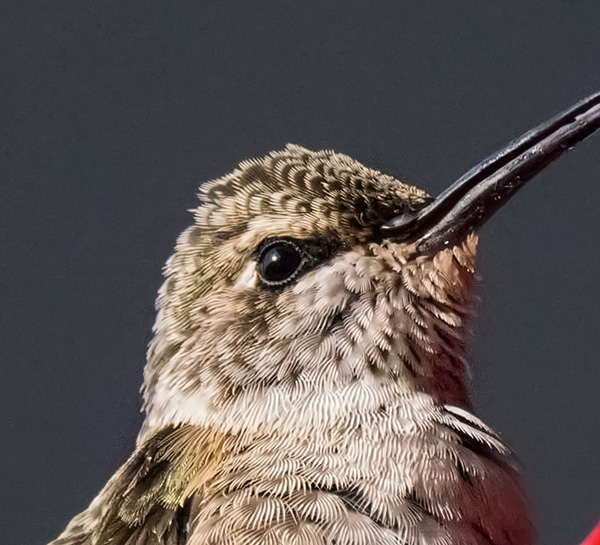 This is the final. I used the Tonality software from MacPhun to sharpen the feathers a bit more. “Wait a minute Bob! isn’t tonality made for making an image black and white?” You bet. But, I liked the controls that allowed me to sharpen small details and micro control the contrast in different areas of the image. The secret is to do this on a separate layer and change the Layer Mode to Luminosity in Photoshop. Then only the information that is Luminous is applied to the image. Using a Layer Mask, I applied the sharpening to only the feathers.
This is the final. I used the Tonality software from MacPhun to sharpen the feathers a bit more. “Wait a minute Bob! isn’t tonality made for making an image black and white?” You bet. But, I liked the controls that allowed me to sharpen small details and micro control the contrast in different areas of the image. The secret is to do this on a separate layer and change the Layer Mode to Luminosity in Photoshop. Then only the information that is Luminous is applied to the image. Using a Layer Mask, I applied the sharpening to only the feathers.
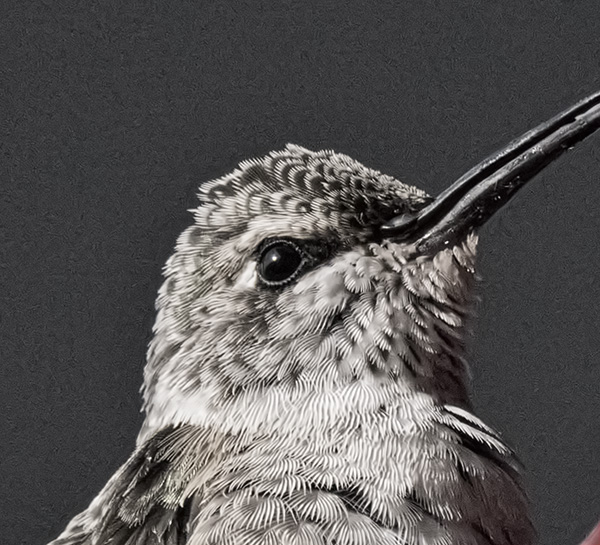 Here is the Tonality layer without a mask. You can see where it sharpened the background as well hence the use of the Mask in Photoshop in addition to changing to the Luminosity Mode.
Here is the Tonality layer without a mask. You can see where it sharpened the background as well hence the use of the Mask in Photoshop in addition to changing to the Luminosity Mode.
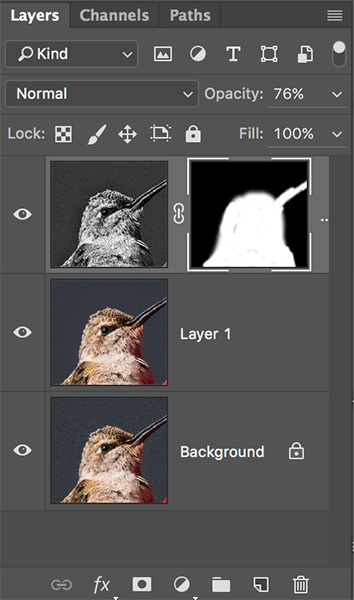 Here’s the Layers Palette. Background Layer is original capture. Layer 1 is with noise removal. Top Layer is Tonality with a mask.
Here’s the Layers Palette. Background Layer is original capture. Layer 1 is with noise removal. Top Layer is Tonality with a mask.
Yours in Creative Photography, Bob
Save
Save
Save

by successfulbob | imaging competition, photography, photography creativity, photography education, tuesday painterly photo art
Tuesday Painterly Photo Art
Karen Nakamura – M.Photog.,M.Artist
Judging gets you exposed to a lot of imagery. You can be critically thinking and talking about thousands of photographs over the course of a year. What is interesting is that there are some artists whose work seems to jump out from the rest showing something different. Judging is blind as far as knowing who the maker may be during the competition. At a later date a maker’s work may be seen with a name attached and I really enjoy talking with the maker and Karen was one of those people.
That’s why I asked her to join us on Successful-Photographer in this post. Here’s Karen!
How Karen learned
“I’ve been creating art pretty much as far back as I can remember. I’ve taken art classes since the 3rd grade. I’m really lucky because my mom would give us art projects throughout the year when I was little. I’ve taken everything from painting, drawing, sculpting, 2 and 3-dimensional design, photography, photoshop and industrial arts.”
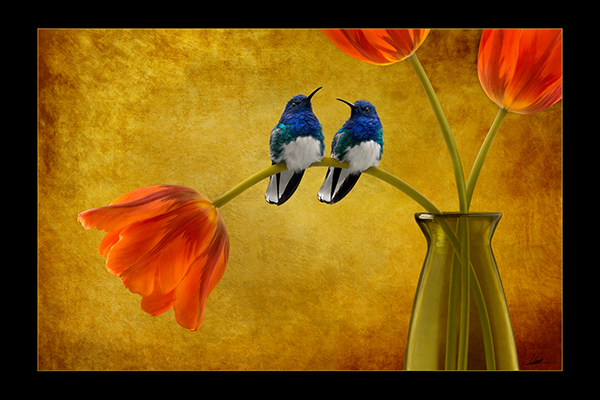 The Perfect Perch – I’ve been wanting to add birds to my floral images. I went to the San Diego zoo and photographed a beautiful White-necked Jacobin hummingbird. I then photographed the tulips to match the light on the bird and then photographed the vase.
The Perfect Perch – I’ve been wanting to add birds to my floral images. I went to the San Diego zoo and photographed a beautiful White-necked Jacobin hummingbird. I then photographed the tulips to match the light on the bird and then photographed the vase.
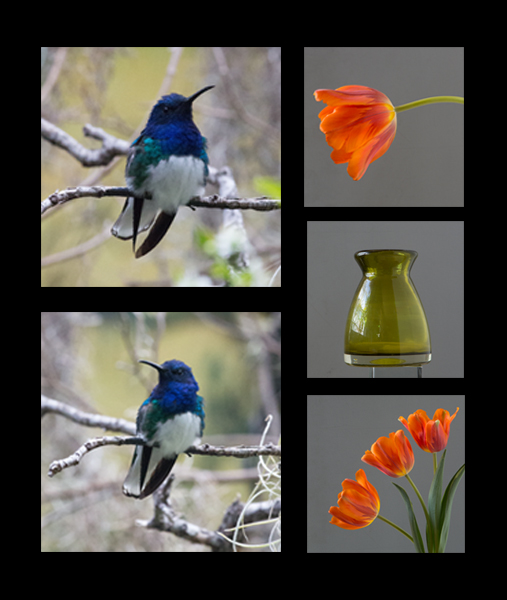 The vase wasn’t exactly what I wanted so I decided to stretch it. The hummingbird was shot natural light at f13 1/160 800ISO Tulips and vase were shot with natural light with reflector. F11 1/60 160ISO
The vase wasn’t exactly what I wanted so I decided to stretch it. The hummingbird was shot natural light at f13 1/160 800ISO Tulips and vase were shot with natural light with reflector. F11 1/60 160ISO
Words of wisdom on learning and/or thoughts on creating art
“Anyone can create art. Just follow your heart. Don’t compare yourself to others and don’t care what others think. Create art that makes you happy because that’s what it’s all about. The more you create, the better you will become. Eventully you will develop your own style.”
 Orchid Bloom – I’ve had this orchid for about five years. The plant sits on my kitchen cabinet and when the window light hits the flowers, the colors are so striking. The orchid spray wasn’t perfect so I added one more flower to the stem. The leaves were taken from another orchid image to complete my piece.
Orchid Bloom – I’ve had this orchid for about five years. The plant sits on my kitchen cabinet and when the window light hits the flowers, the colors are so striking. The orchid spray wasn’t perfect so I added one more flower to the stem. The leaves were taken from another orchid image to complete my piece.
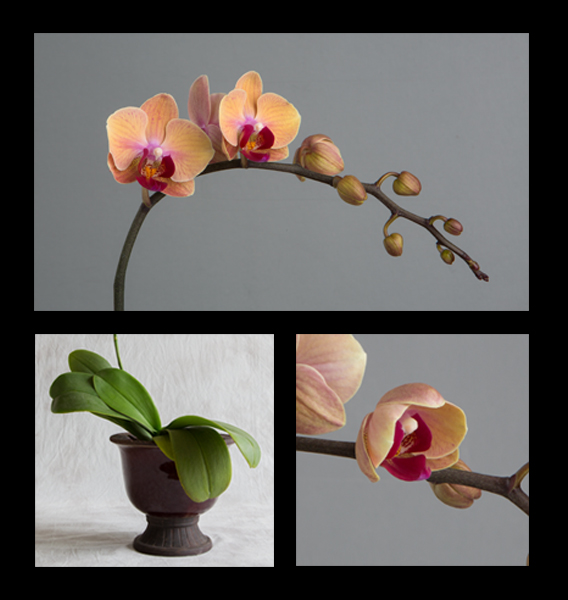 The orchid spray was shot in a studio setting with one main light and one reflector. @ f16 1/125 100 ISO The orchid plant was natural window light with a reflector. F11 1/60 400ISO
The orchid spray was shot in a studio setting with one main light and one reflector. @ f16 1/125 100 ISO The orchid plant was natural window light with a reflector. F11 1/60 400ISO
“To be inspired look at other peoples art, look at art history books and go onto social media sites like pinterst and instagram. Follow artists that inspire you. To learn how to create art, watch videos on Youtube or watch videos on site like Creative Live. Hands on classes and workshops are one of the best ways to learn a techique.”
 Delicate Beauty – The freesia is one of the first flowers I photographed back in 2012. I really didn’t like how it came out, so I set it aside until I went to the Natural History Museum in Los Angeles and photographed a Swallowtail hovering over flowers. I didn’t know what I wanted to do with my butterfly images until I went back into my library of flowers and came across the freesias again. Visually the light matched so I decided to play around with the three subjects until I created this art piece.
Delicate Beauty – The freesia is one of the first flowers I photographed back in 2012. I really didn’t like how it came out, so I set it aside until I went to the Natural History Museum in Los Angeles and photographed a Swallowtail hovering over flowers. I didn’t know what I wanted to do with my butterfly images until I went back into my library of flowers and came across the freesias again. Visually the light matched so I decided to play around with the three subjects until I created this art piece.
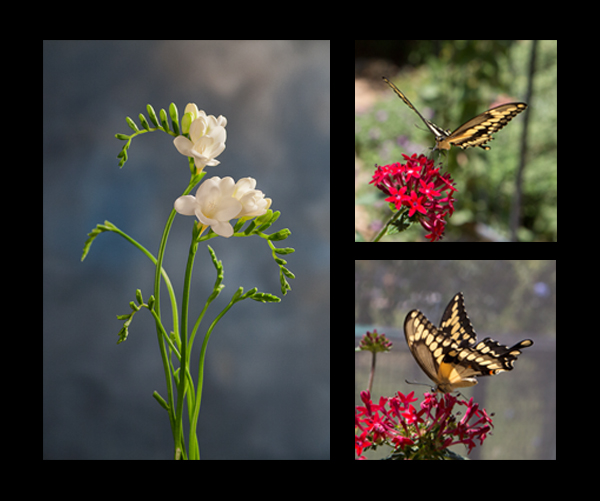 The butterflies were shot in diffused sunlight f8 1/1600 800 ISO. The freesia was studio lit with one main light, one reflector and a backlight. f16 1/125 100ISO
The butterflies were shot in diffused sunlight f8 1/1600 800 ISO. The freesia was studio lit with one main light, one reflector and a backlight. f16 1/125 100ISO
Karen Nakamura Bio
PPA Master Photographer and Master Artist, Karen Nakamura, is widely acclaimed for her signature style images of flowers. She is gifted with a unique take on them that evolves with each new blossom she shoots. Some of her inspiration and creativity comes from an adoration of orchids, which she tended to as a hobby.
Karen also has a fine art background, attaining her Bachelor’s of Fine Art from Cal State Long Beach.
Karen has earned the Professional Photographers of America’s Photographer of the Year awards every year since she first entered the PPA International Photographic Competition back in 2010.
Professional Photographers of America honored Karen with its 2013 Diamond Photographer of the Year and 2014 Artist Diamond Photographer of the Year. Diamond Photographers of the Year had all four competition images accepted into the prestigious PPA Loan Collection. Karen has won the coveted Canon Par Excellence Award, representing the pinnacle of achievement at the Professional Photographers of America regional level. She is one of the first photographers to earn the California Masters Degree from Professional Photographers of California.
You can learn from Karen! Her PPA Super 1 Day Class
Floral Photography and Compositing Course Date: Thursday, October 6, 2016
PPA Super One Day Class
Check out more of Karen’s work – www.karennakamuraphotography.com
Hope you enjoyed Karen’s work!
Yours in Creative Photography, Bob
Save
Save
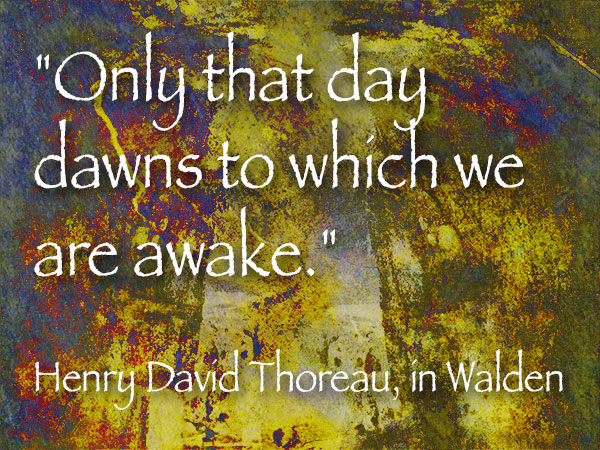
by successfulbob | inspiration, photography, photography - art quote, photography education, success education
Sunday Photo/Art Quote – Henry David Thoreau
Sometimes I head a little far afield of even the art world when I choose the quotes for this Sunday morning art thought.
Today is one of those days.
But I’ll bring it around. I promise.
Walden by Thoreau is an interesting read and his sharing of thoughts on slowing down and observing the world in which we hang out in real time and that it is a good idea. You don’t have to take as much time as he did, but you can slow down and observe for small chunks of time.
I find it quite helpful. On to today’s quote, so we are on the same page.
 “Only that day dawns to which we are awake.” Henry David Thoreau
“Only that day dawns to which we are awake.” Henry David Thoreau
I share this idea today because I find many people, including myself, often living in the past or the future instead of the present. Don’t believe me? Ever drive home and then wonder how you got there? In the shower do you feel the water cascading from your head down your body and hear the musical splashing of the drops onto the floor? Or, are you on auto-pilot missing these moments and planning what you should be doing after you get to work? Or are you wallowing in the past upset with something someone said and replaying that conversation over and over ad nauseum??
Other examples abound. Reading and not know what you’ve read moments later. Shaving your face and missing the whole left side. Brushing your teeth and not knowing whether you’ve done the top inside yet. You get the idea.
We can become better creators if we learn to be in the present and learn to observe more. See more details, Retain more of those details. For help with seeing more and recalling what you see, you might want to try Amy Herman’s book Visual Intelligence. It’s a guide to visual understanding and communicating more clearly. Her book is based on a course for law enforcement, such as the FBI, police officers and CEO’s, ER professionals to become more observant.
Getting control of our thoughts is the first step. Slowing the constant cascade of the unstructured noise that our brains are capable of generating. Meditation can be of tremendous help in quieting the mind. I recommend Jon Kabat-Zinn and his book Wherever You Go There You Are. He also has a set of guided meditations that are wonderful as you start down the road of being in the here and now. Mindfulness Meditations.
Hope you enjoy this reading list. I hadn’t intended to go this deep. Sometimes writing can lead you to a rabbit hole, and the exploration can take you to interesting places. Just ask Alice.
Yours in Creative Photography, Bob
PS – Here’s the tie in. When you see better and remember what you see you can be a better creator of images. Happy reading!
 Walden by Henry David Thoreau
Walden by Henry David Thoreau
 Visual Intelligence – Amy E. Herman
Visual Intelligence – Amy E. Herman
 Wherever You Go There You Are – Jon Kabat-Zinn
Wherever You Go There You Are – Jon Kabat-Zinn
Save
Save
Save

by successfulbob | fine art photography, photography - art quote, photography education
Sunday Photo/Art Quote – Ralph Waldo Emerson
Reaching out to other arts for quotes is a way to keep from becoming inbred in my thinking. If I were only to search for artistic inspiration from other photographers, I believe there would be a large hole in our education moving forward. Today’s quote is from Ralph Waldo Emerson who is best known, by me, as a poet. But he was also an essayist and lecturer focused on individuality and freedom.
I love the thought he expressed here.
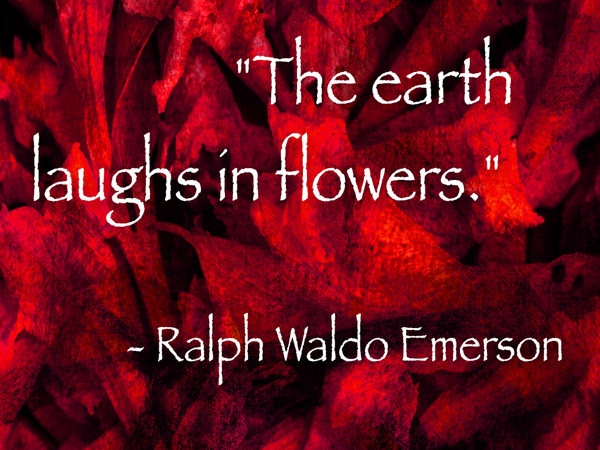 “The earth laughs in flowers.” – Ralph Waldo Emerson
“The earth laughs in flowers.” – Ralph Waldo Emerson
These five words make me think of the earth and flowers in such a different manner, You wouldn’t think that such a few number of words could open a huge number of thoughts within the brain. Maybe it doesn’t do it for you. Let me know. These words tickle my fancy and make me want to create images in a slightly different manner.
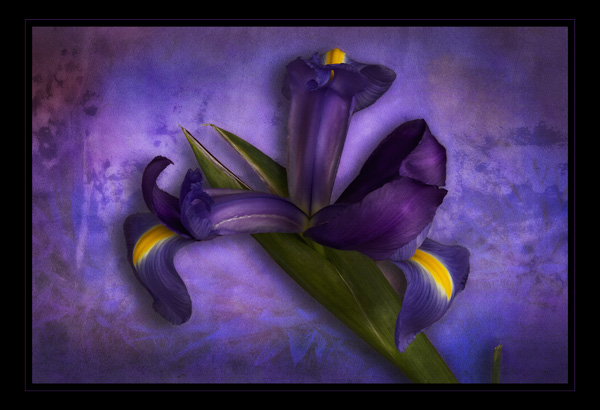 ‘Iris’ – Accepted into the Professional Photographer of America Loan Collection in 2014
‘Iris’ – Accepted into the Professional Photographer of America Loan Collection in 2014
It’s wonderful to grab inspiration from many different places.
from where are you currently drawing your inspiration?
Yours in Creative Photography, Bob

by successfulbob | fine art photography, imaging competition, photography, photography competition, photography creativity, photography education, wildlife photography
International Photographic Competition – Pt 3
Finally!
I can get some work done.
Like many photographers around the country, I have been watching the judging of the International Photographic Competition hosted by the Professional Photographers of America (PPA).
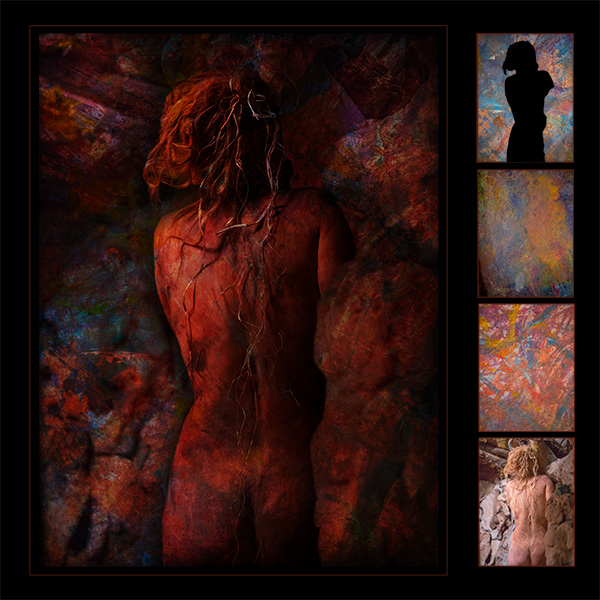 ‘Hiding’ – General Collection Artist Category – This image of model and mask, performer, and artist Pash Gabalvy of Sedona was an effort to create a painterly feel to this capture. May have processed this one a bit too dark.
‘Hiding’ – General Collection Artist Category – This image of model and mask, performer, and artist Pash Gabalvy of Sedona was an effort to create a painterly feel to this capture. May have processed this one a bit too dark.
I submitted eight images. Four in the Photographic Open and four in the Artist category. Of the eight images presented, Three images were not accepted. One was accepted into the General Collection earning a Merit. Four were deemed to be ‘best of the best’ and accepted into the prestigious Loan Collection.
I can share the ‘less successful’ images that Merited or were not accepted, but not the Loan Collection images as there will be additional judging of those images for the Grand Imaging Awards which will be announced at the Imaging USA convention in San Antonio, TX in January.
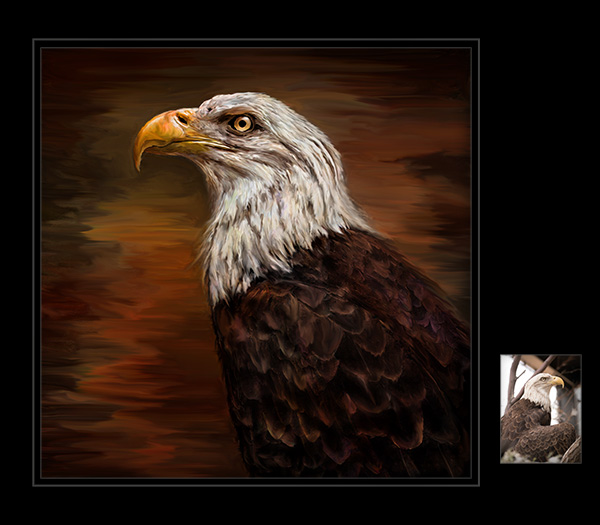 ‘Eagle’ – Was not accepted. The Artist Category is judged based on the final image but also the difficulty and execution of the artwork itself. I will rework this image and try again.
‘Eagle’ – Was not accepted. The Artist Category is judged based on the final image but also the difficulty and execution of the artwork itself. I will rework this image and try again.
Notice I did not say, ‘unsuccessful’ I said, ‘less than successful.’ We always want our images to score well, but I believe I learn just as much, if not more, from those that don’t. Why? I have been experimenting with lots of new capture techniques, new painting techniques in creating art from my images and different ways of processing photos. I get feedback on why the treatments and processing didn’t work, and I can grow my skills with that information.
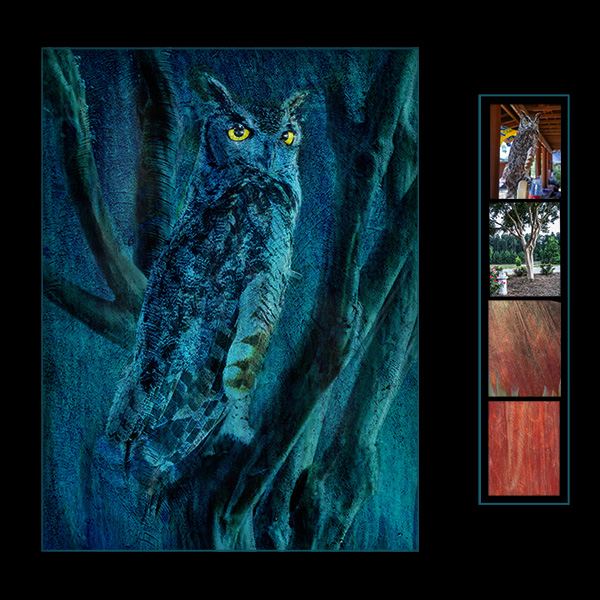 ‘Nightwatch’ – Another Artist submission that fell short in the judge’s opinions. This was challenged, so I received feedback on what the judges found lacking. “No specular highlights on the beak. Some leaves the were a distraction behind the owl’s head. Not enough shape and form on the owl’s body.” I agree with all contentions and will be reworking this image again.
‘Nightwatch’ – Another Artist submission that fell short in the judge’s opinions. This was challenged, so I received feedback on what the judges found lacking. “No specular highlights on the beak. Some leaves the were a distraction behind the owl’s head. Not enough shape and form on the owl’s body.” I agree with all contentions and will be reworking this image again.
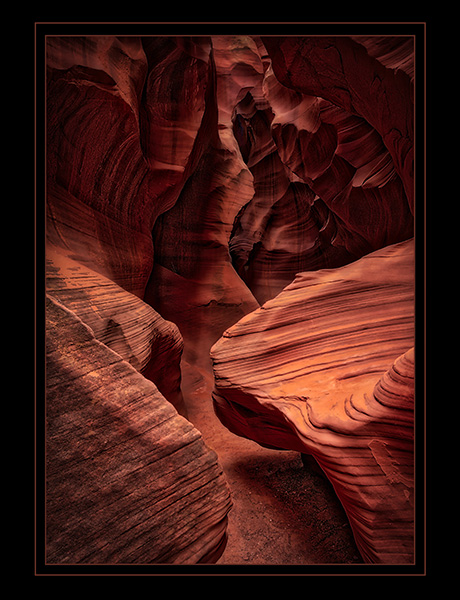 ‘Secret Canyon’ – Not accepted n the Photographic Open Category
‘Secret Canyon’ – Not accepted n the Photographic Open Category
I did not receive feedback on this image yet. My guess is that it might be a little too artistic for the subject. Many pictures of slot canyons have been entered over the years.
That’s my story so far. I’ll follow up with the Loan Collection images after the GIA’s have been selected.
Yours in Creative Photography, Bob
Save
Save

by successfulbob | photography - art quote, photography creativity, photography education
Sunday Photo/Art Quote – Robert Genn
The Painter’s Keys. An excellent twice weekly newsletter was started by Canadian artist Robert Genn. Robert is no longer with us, but the bi-weekly letter and website were carried on by his daughter Sara who is a talented artist and writer in her own right.
Robert was not only a talented acrylic on canvas artist recognized throughout the world for his work depicting the west coast of Canada, but he was also a thinker on the process of creating art. That’s why I grabbed a quote from him for use this morning.
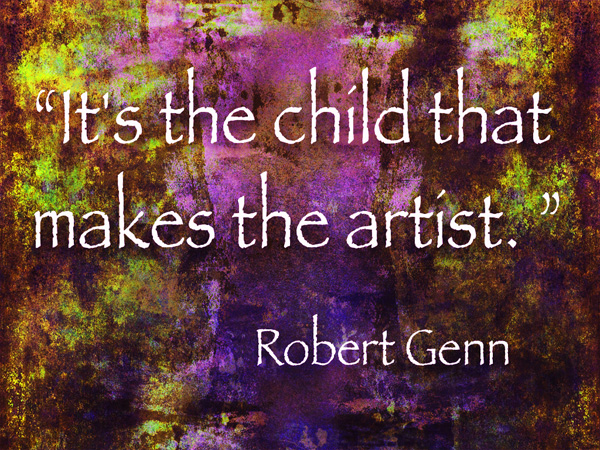 “It’s the child that makes the artist.” – Robert Genn
“It’s the child that makes the artist.” – Robert Genn
In my opinion, this quote is a very simple but important one. There is a tendency to loose our inner child as we grow up and into our careers. When we first try our hand at art as a child, we work with abandon and no thought of what is ‘right of wrong’ we just do. As we age, we begin to listen and be shaped by the outside world of parents and teachers and supposed friends who tell us what is wrong with our work. How we can’t make a living as artists. How we could do something better if we just did it the approved way.
To grow as artists, I suggest that we go back to that inner child now and then and just play with wild abandon. Try something new. Push boundaries. Don’t label something as good or bad but as a learning experience. I talk about this many times, but it’s a message that will help you forge new art in your life. Don’t be afraid to make mistakes. Don’t listen to people that tell your work is not up to par it doesn’t matter. Play. Play some more. Study new ideas and try to put them into practice.
![dreams_brain-scan]() From Sara Genn’s Latest Letter/Post – “Your Brain on Art’
From Sara Genn’s Latest Letter/Post – “Your Brain on Art’
Scientists ‘read dreams’ using brain scans. Rebecca Morelle, BBC science
Will this result in masterpieces immediately? Many times no. But often it can lead you down a new path to help you become a more creative individual. Picasso had a quote along similar lines, “Every child is an artist. The problem is how to remain an artist once we grow up.” – Pablo Picasso
Don’t let the world take out your inner child.
Yours in Creative Photography, Bob
PS – You can click on either link in this post to check out and subscribe to the Painter’s Keys

 Hummingbird Straight out of the camera. He’s checking me out.
Hummingbird Straight out of the camera. He’s checking me out. After seeing me, he stuck out his tongue! Not sure if that was social commentary or not. Here’s the little guy after processing with MacPhun Noiseless and MacPhun Tonality (for sharpening the feathers just a bit more. Explanation below)
After seeing me, he stuck out his tongue! Not sure if that was social commentary or not. Here’s the little guy after processing with MacPhun Noiseless and MacPhun Tonality (for sharpening the feathers just a bit more. Explanation below) Here’s the image after running MacPhun’s Noiseless software. There are lots of settings and possibilities. This was a fairly aggressive treatment. It smoothed out the noise in the background nicely without losing detail in the feathers.
Here’s the image after running MacPhun’s Noiseless software. There are lots of settings and possibilities. This was a fairly aggressive treatment. It smoothed out the noise in the background nicely without losing detail in the feathers. This is the final. I used the Tonality software from MacPhun to sharpen the feathers a bit more. “Wait a minute Bob! isn’t tonality made for making an image black and white?” You bet. But, I liked the controls that allowed me to sharpen small details and micro control the contrast in different areas of the image. The secret is to do this on a separate layer and change the Layer Mode to Luminosity in Photoshop. Then only the information that is Luminous is applied to the image. Using a Layer Mask, I applied the sharpening to only the feathers.
This is the final. I used the Tonality software from MacPhun to sharpen the feathers a bit more. “Wait a minute Bob! isn’t tonality made for making an image black and white?” You bet. But, I liked the controls that allowed me to sharpen small details and micro control the contrast in different areas of the image. The secret is to do this on a separate layer and change the Layer Mode to Luminosity in Photoshop. Then only the information that is Luminous is applied to the image. Using a Layer Mask, I applied the sharpening to only the feathers. Here is the Tonality layer without a mask. You can see where it sharpened the background as well hence the use of the Mask in Photoshop in addition to changing to the Luminosity Mode.
Here is the Tonality layer without a mask. You can see where it sharpened the background as well hence the use of the Mask in Photoshop in addition to changing to the Luminosity Mode. Here’s the Layers Palette. Background Layer is original capture. Layer 1 is with noise removal. Top Layer is Tonality with a mask.
Here’s the Layers Palette. Background Layer is original capture. Layer 1 is with noise removal. Top Layer is Tonality with a mask.




























